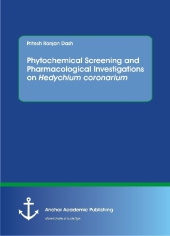 Neuerscheinungen 2016Stand: 2020-02-01 |
Schnellsuche
ISBN/Stichwort/Autor
|
Herderstraße 10
10625 Berlin
Tel.: 030 315 714 16
Fax 030 315 714 14
info@buchspektrum.de |

Pritesh Ranjan Dash
Phytochemical Screening and Pharmacological Investigations on Hedychium coronarium
2016. 76 S. 26 Abb. 220 mm
Verlag/Jahr: ANCHOR ACADEMIC PUBLISHING 2016
ISBN: 3-9606703-6-2 (3960670362)
Neue ISBN: 978-3-9606703-6-0 (9783960670360)
Preis und Lieferzeit: Bitte klicken
The present study was carried out for phytochemical screening and pharmacological investigations on methanolic extract of rhizomes of Hedychium coronarium (Local name: Dolan Champa, Family: Zingiberaceae). In this study, the possible analgesic and CNS (Central Nervous System) depressant activities of the methanolic rhizome extract of Hedychium coronarium were investigated at the doses of 100 mg/Kg, 200 mg/kg and 400 mg/Kg body weight on mice by oral administration. The analgesic activities were investigated for their central and peripheral pharmacological actions using tail immersion testing and acetic acid-induced writhing testing respectively. Its CNS depressant activity was evaluated by using hole cross and open field tests and the cytotoxic activity was observed using brine shrimp lethality bioassay.
´Text sample:
Chapter 3.4.1 Analgesic activity test for the crude extract of Hedychium coronarium:
Study of analgesic activity of crude extract of Hedychium coronarium by acetic acid induced writhing method has been adopted in the Pharmacology Laboratory of the Department of Pharmacy, Stamford University Bangladesh on mice model.
Analgesic drugs which are currently in use are either narcotics or non-narcotics which have proven side and toxic effects. To develop new synthetic compounds in this category is an expensive venture and again may have problems of side effects. On the contrary, many medicines of plant origin had been used and are in use successfully since long time without any serious effects ( Ikram, 1983).
Pain has been officially defined as an unpleasant sensory and emotional experience associated with actual or potential tissue damage. Pain acts as a warning signal against disturbances of the body and has a proactive function (Tripathi, 1999).
Analgesic means a drug that selectively relieves pain by acting in the CNS or on peripheral pain mechanisms, without significantly altering consciousness. So, analgesic activity means capacity of a substance to neutralize the pain sensation (Rang, 1993).
The lack of potent analgesic and anti-inflammatory drugs now actually in use prompted the present study, in which rhizomes of Hedychium coronarium had been selected for ist reported biological activities in indigenous system of medicine.
Acetic acid induced writhing test:
Objectives:
The purpose of this study was to examine analgesic effect of methanolic extract of rhizome of Hedychium coronarium on mice in a peripheral model of analgesic activity test.
Principle:
The acetic acid induced writhing method is an analgesic behavioral observation assessment method that demonstrates a noxious stimulation in mice. The test consists of injecting the 0.7% acetic acid solution intraperitoneally and then observing the animal for specific contraction of body referred as writhing. A comparison of writhing was made between positive control (diclofenac), control and test sample given orally 30 minutes prior to acetic acid injection. If the sample possesses analgesic activity, the animal that received the sample will give lower number of writhing than the control, i.e. the sample having analgesic activity will inhibit writhing.Diclofenac-Na is used as standard drug [...].
Experimental Animal:
Young Swiss albino mice aged 3-4 weeks, average weight 25 gm. Were used for the experiment. The mice were purchased from the animal research branch of the International Centre for Diarrhoeal Diseases and Research, Bangladesh (ICDDR, B). For this experiment, five groups (I, II, III, IV and V) of mice were used and each group contains 5 mice.
Experimental Design:
The method described by Howlader et al. (2006) was adopted to study the effect of the Hedychium coronarium extract on acetic acid induced writing test. Test samples and control were given orally by means of a feeding needle. A thirty (30) minutes interval was given to ensure proper absorption of the administered substances. Then the writhing inducing chemical, acetic acid solution (0.7%) was administered intraperitoneally to each of the animals of a group. After an interval of fifteen (15) minutes, this was given for absorption and no of squirms (writhing) was counted for 5 minutes.
Preparation of the Test Materials:
To prepare solution of the plant extract at a doses of 100 mg/kg, 200mg/kg and 400mg/kg body weight, 180 mg extract was measured and added with it 9 ml of distilled water and mixing with the help of vortex apparatus. From this solution 5ml/kg was taken for 100mg/kg, 200mg/kg and for 400 mg/kg dose respectively [...].
Mechanism of pain induction in acetic acid induced writhing method:
Acetic acid is a pain stimulus. Intraperitoneal administration of acetic acid (0.7%) causes localized in


